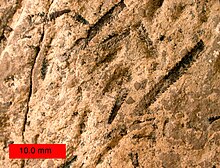Graptolites
| Graptolites Temporal range: Mid Cambrian to Carboniferous, |
|
|---|---|
 |
|
| Amplexograptus from the Ordovician near Caney Springs, Tennessee. | |
| Scientific classification | |
| Kingdom: | Animalia |
| Phylum: | Hemichordata |
| Class: | †Graptolithina |
| Orders | |
Graptolithina is a class of hemichordate animal, the members of which are known as graptolites. Graptolites are fossil colonial animals known chiefly from the Upper Cambrian through the Lower Carboniferous (Mississippian). A possible early graptolite, Chaunograptus, is known from the Middle Cambrian.
The name graptolite comes from the Greek graptos, meaning "written", and lithos, meaning "rock", as many graptolite fossils resemble hieroglyphs written on the rock. Linnaeus originally regarded them as 'pictures resembling fossils' rather than true fossils, though later workers supposed them to be related to the hydrozoans. More recent work places them near the pterobranchs, possibly within.
One analysis suggests that the Pterobranchia represent extant graptolites.
The name "graptolite" originates from the genus Graptolithus, which was used by Linnaeus in 1735 for inorganic mineralizations and crustations which resembled actual fossils. In 1768, in the 12th volume of Systema Naturae, he included G. sagittarius and G. scalaris, respectively a possible plant fossil and a possible graptolite. In his 1751 Skånska Resa, he included a figure of a "fossil or graptolite of a strange kind" currently thought to be a type of Climacograptus (a genus of biserial graptolites). Later workers used the name to refer to a specific group of organisms. Graptolithus was officially abandoned in 1954 by the ICZN, partly because of its original purpose as a grouping for inorganic mimicries of fossils. (Bulman, 1970: V 6)
...
Wikipedia
